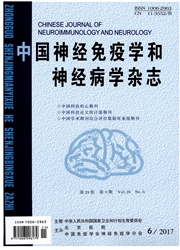

 中文摘要:
中文摘要:
目的探讨多发性硬化(multiple sclerosis,MS)患者的嗅觉功能。方法应用"T﹠T嗅觉仪"检测30例MS患者及30名年龄和性别匹配的健康对照的嗅觉识别阈值(identification threshold,IT)和嗅觉感知阈值(detection threshold,DT),并采集患者的病史,进行临床和神经心理评估,包括扩展的功能障碍状况量表(expanded disability status scale,EDSS)和贝克抑郁自评问卷(Beck depression rating scale,BDI),根据IT、DT结果是否正常及病程分组,分析各组IT、DT情况及其与其临床特征的关系,并分析MS患者IT、DT与BDI评分的相关性,探讨嗅觉与抑郁的关系。结果 MS患者的IT〔0.7(-2,4)vs.-0.1(-1.1,0.7),u=247.500,P=0.003〕,及DT〔-2(-2,-0.4)vs.-2(-2,-1.9),u=333.000,P=0.016〕均高于健康对照组;病程≥2年者多出现识别功能受损,MS患者中识别障碍组的EDSS评分高于识别正常组(P=0.017)。MS组IT及DT与BDI评分无相关性(分别r=0.200,P=0.289;r=-0.0209,P=0.913),MS组嗅觉障碍亚组IT及DT与BDI评分亦无相关性(r=0.0899,P=0.750;r=-0.131,P=0.642)。结论 MS患者存在嗅觉功能障碍,且嗅觉功能与抑郁可能不相关。
 英文摘要:
英文摘要:
Objective To assess olfactory function in patients with multiple sclerosis(MS).MethodsThe scores of odour identification threshold(IT)and odour detection threshold(DT)were evaluated by Japanese TT olfactometer threshold test for 30 MS patients and 30 age and sex matched healthy controls. Medical history,clinical and neuropsychological evaluation,including Expanded Disability Status Scale(EDSS)and Beck depression rating scale(BDI)were collected.According to the results of IT,DT and disease course,patients were divided into different groups.The scores for IT and DT between different MS groups and its correlation with clinical characteristics and BDI score were analyzed.Results The scores of odour IT [0.7(-2,4)vs.-0.1(-1.1,0.7),u=247.500,P=0.003]and odour DT [-2(-2,-0.4)vs.-2(-2,-1.9),u=333.000,P=0.016]were higher in the MS group than in the healthy controls.Olfactory IT was impaired in patients with a disease duration longer than 2years.The EDSS score of the MS patients with impaired odour identification function was higher than those of the MS patients with normal odour identification function(P=0.017).BDI score did not correlate with the IT or DT values in MS patients(r=0.200,P=0.289;r=-0.0209,P=0.913),and BDI score did not correlate with the IT or DT values in MS patients with olfactory dysfunction(r=0.0899,P =0.750;r=-0.131,P =0.642).Conclusions MS patients could have the olfactory dysfunction and the olfactory dysfunction had no correlation to depression symptoms.
 同期刊论文项目
同期刊论文项目
 同项目期刊论文
同项目期刊论文
 Interleukin-10 producing-B cells and their association with responsiveness to rituximab in myastheni
Interleukin-10 producing-B cells and their association with responsiveness to rituximab in myastheni Anti-Inflammatory Effects of Vinpocetine in Atherosclerosisand Ischemic Stroke: A Review of the Lite
Anti-Inflammatory Effects of Vinpocetine in Atherosclerosisand Ischemic Stroke: A Review of the Lite Clinical Features and Sera Anti-Aquaporin 4 Antibody Positivity in Patients with Demyelinating Disor
Clinical Features and Sera Anti-Aquaporin 4 Antibody Positivity in Patients with Demyelinating Disor INTERLEUKIN-10 PRODUCING- B CELLS AND THEIR ASSOCIATION WITH RESPONSIVENESS TO RITUXIMAB IN MYASTHEN
INTERLEUKIN-10 PRODUCING- B CELLS AND THEIR ASSOCIATION WITH RESPONSIVENESS TO RITUXIMAB IN MYASTHEN 期刊信息
期刊信息
